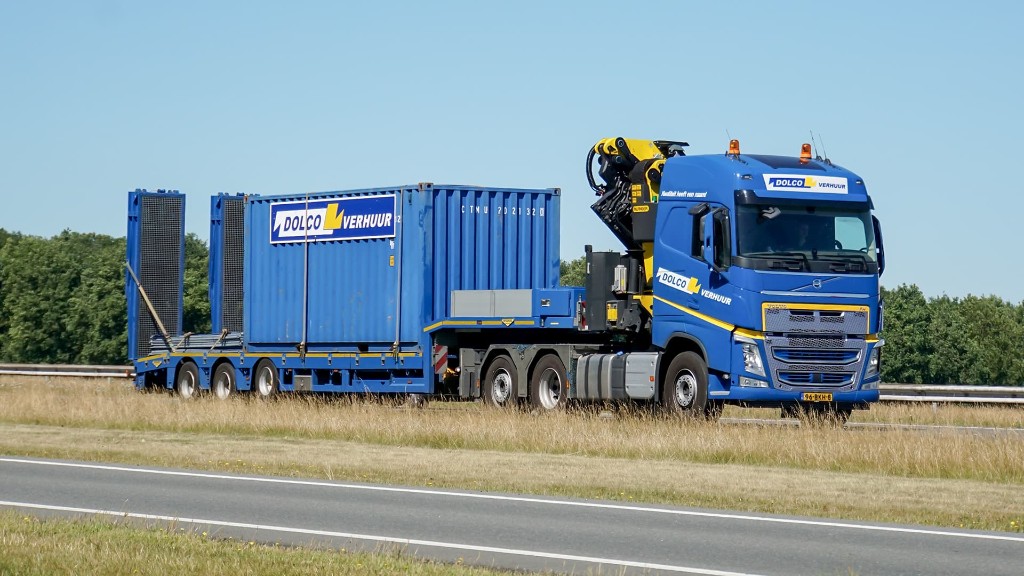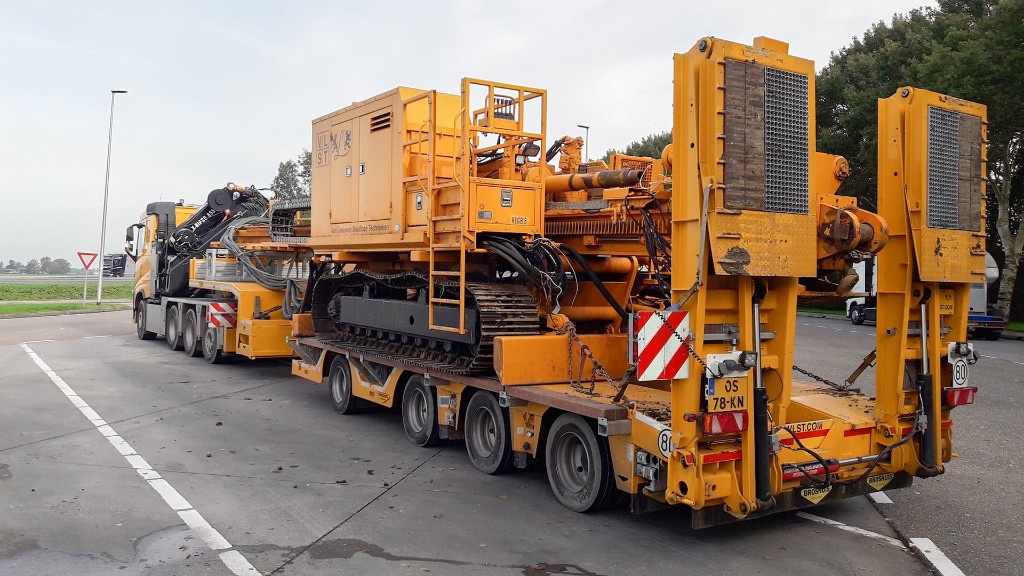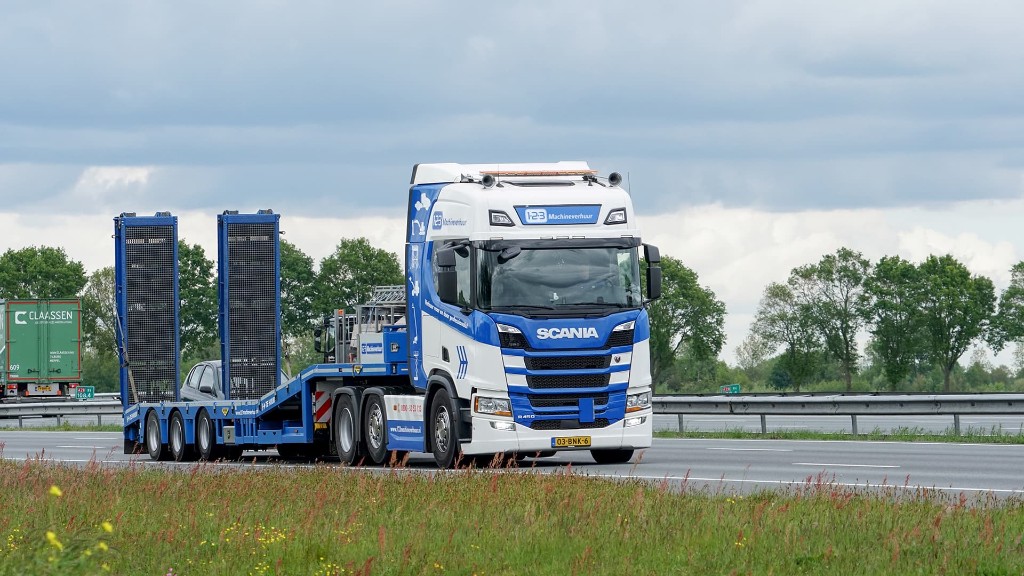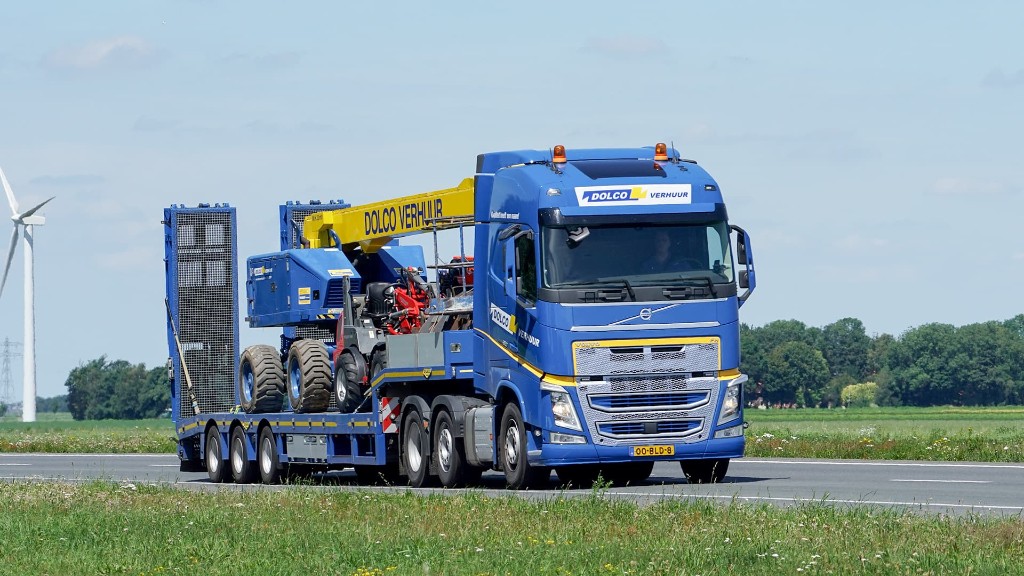Ask us
your question!
Ramps
The new range of ramps provides you with various lengths, widths and configurations. We also have our well-known ECO ramp and loose aluminium ramps. So many different choices, but when should you choose what ramp? In this blog, we will explain when it is best to choose each type of ramp.
First of all, it is important for you to know the aspects you should take into account:
The choice of ramp is always determined by the cargo you will be transporting with it. Does the cargo have enough ground clearance so it does not hung up on a steep ramp angle, and does the cargo have enough ‘power’ to drive up a steep ramp?
The frequency of use of the ramps will also determine whether ease of use becomes a decisive factor. If the ramps are used intensively, you will probably be more inclined to choose a hydraulically operated ramp. An electro-hydraulic pump is incorporated into the chassis for folding the ramps up and down and to adjust the ramp width. The various functions of the ramps are controlled from a central control unit.
However, there are also other points to consider, such as:
- Costs
- Tare weight
- Fuel saving
A chart is given below in which each type of ramp is assigned a score on these points. (1=more favourable, 6=least favourable)
| Advantages and disadvantages of each type of ramp | Single ramps | Double ramps | Extra long double ramps | Extra long and extra wide double ramps | ECO ramp | Aluminium ramps |
|---|---|---|---|---|---|---|
| Costs | 2 | 4 | 5 | 6 | 2 | 1 |
| Tare weight | 3 | 4 | 5 | 6 | 2 | 1 |
| Fuel saving | 4 | 3 | 5 | 6 | 2 | 1 |
| Ramp angle | 4 | 3 | 1 | 1 | 6 | 5 |
Hydraulic ramps
Single ramps
Single ramps with a slope of 13° provide an excellent solution for most construction machinery such as excavators and dumpers. These vehicles usually have enough ground clearance and power to drive over ramps with a steep slope. If you are certain that you will almost always be transporting these vehicles, a single ramp is a good choice. The single ramp is lightweight and is lower-priced than the other hydraulic ramps.
This ramp is 3043 mm long, making it higher than the collapsed double ramps, which are 2564 mm high. The single ramps will create slightly more drag, and are therefore a fraction more expensive in fuel.
Another advantage of the single ramps is that they are width-adjustable, making it possible to load all types of vehicles. Furthermore, the space between the ramps allows a boom/crane arm well to fit in between, meaning that you do not necessarily have to drive with the ramp extended.
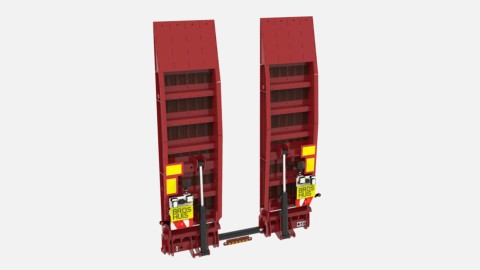
Double ramps
The double ramps have a slope of only 11° and therefore provide a solution for many more types of vehicles such as larger forklifts, elevating work platforms, and road building machines. This type of ramp is often compared with the extra long double ramps. These ramps are also width-adjustable and a boom well also fits in between.
The double ramps are shorter than the ‘extra long double ramps’. As a result, the regular double ramp creates less drag and saves you fuel. Furthermore, this ramp is slightly cheaper and lighter than the extra long version. On the other hand, if you do transport vehicles with very little ground clearance, perhaps you will still need the extra long double ramps, because their slope angle is not as steep.
Extra long double ramps
With a slope of only 8 degrees, it is easiest to drive on and off with all types of cargo with these ramps. Consider loading and unloading forklifts, small elevating work platforms and reach trucks. These ramps are also width-adjustable, and a boom well/crane arm fits exactly between the ramps.
This ramp is the best choice if you want to be able to transport many different types of cargo with low ground clearance, but if you are not sure about this, it is important to consider the following points in your decision. This extra long ramp is longer than a regular ‘double ramp’ and therefore creates more drag, resulting in higher fuel consumption. This ramp is also heavier and more expensive than the ‘single ramp’ or the ‘double ramp’. A heavy ramp results in less useful load capacity.
Extra long and extra wide double ramps
The extra long ramp can be supplied in an extra wide variant, which is 1250 mm wide. The ramps are installed across the full width of the cargo bed, making it easy for three-wheelers and vehicles with different track widths such as asphalt milling machines to drive on and off as well. This extra wide variant of the extra long ramps offers the solution for very many types of cargo, but unfortunately not for cargoes that require a boom well. A boom well cannot fit between the ramps, meaning that you will need to drive with them extended.
When purchasing a trailer with these ramps, you will also have to consider that this is the most expensive and heaviest variant relative to the ramps above. These ramps also create a lot of drag, which again leads to higher fuel consumption. The width is also not hydraulically adjustable with these ramps.
ECO ramp
The ECO ramp is a flexible and sustainable solution. There is no ramp with less drag than this ramp. Furthermore, this ramp can also be used as an extra bit of cargo bed, allowing you to carry more cargo with the ramp up. The cargo bed can even lift loads up to 10 tons. On the other hand, without extra aluminium ramps, the ramp has a very steep slope angle of 25° degrees. This does offer a solution for larger agricultural machines, but it cannot be used to transport forklifts or elevating work platforms. However, the ECO ramp can always be extended with aluminium ramps to reduce the slope to 11° with a long aluminium ramp or 16° with a short aluminium ramp. This makes it possible to use it for forklifts and elevating work platforms as well.
Non-hydraulic ramps
Aluminium ramp
If you only sporadically use ramps to load the trailer, aluminium ramps can be an excellent alternative. You can usually store the ramps under the cargo floor so you do not need to have the ramps up unnecessarily, as is the case with hydraulic ramps, which increases fuel consumption. These ramps are also lighter than any of the hydraulic ramps, providing a higher useful cargo capacity. This ramp is also the cheapest to purchase. The disadvantage of these ramps is a steeper slope angle of 15 degrees, and it is a loose ramp that the user has to put in place and store manually.
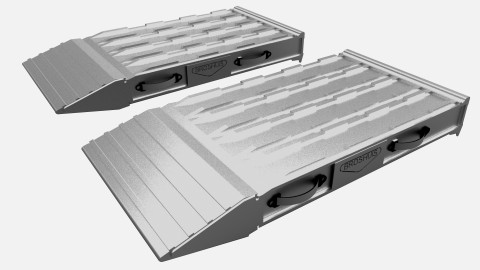
Options that are determined by the cargo
Various other options are also available, such as a ramp provided with special grip strips with extra grip for tracked vehicles, or extra reinforcement for heavy machines.
Removable configuration
If the load protrudes from the rear, the ramp can be in the way. Ramps can come in a removable configuration for this. A lighting bar is then installed in the place of the removed ramp.
Floor
We offer the hardwood floor as standard, and this is the best solution for vehicles with pneumatic tyres and tracked vehicles. In the event that the caterpillar tracks are dirty and you drive them over the grate floor, this will quickly cause damage. Furthermore, the iron caterpillar tracks on the iron grate floor will slip because there is too little grip. A wooden floor will therefore last longer with this cargo.
The grate floor is a good solution for vehicles with solid tyres, and pneumatic tyres can also drive over them without problem. The grate floor provides more grip. An added advantage of the grate floor is that the air passes through it, producing less drag and reducing fuel consumption slightly. On the other hand, the grate floor does not permit as high an axle load.
View our technical page about the ramps

